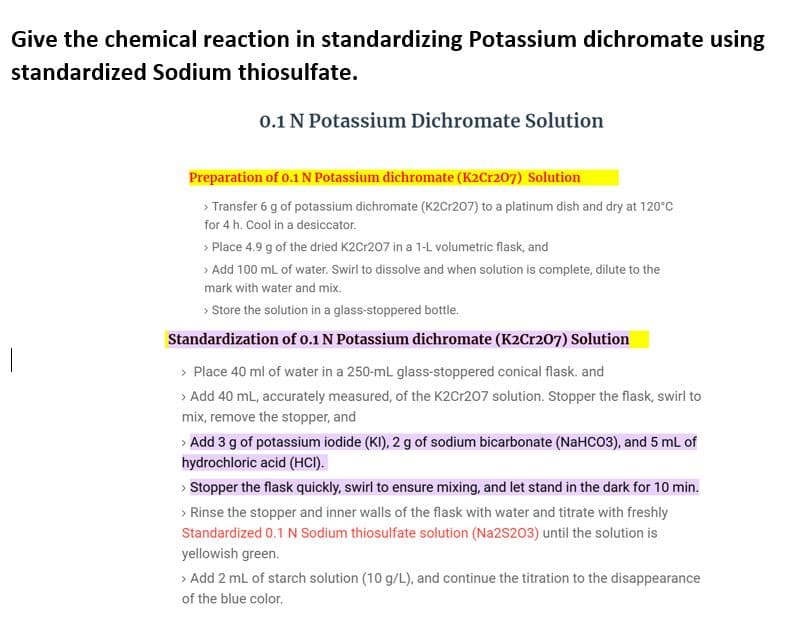Give the chemical reaction in standardizing Potassium dichromate using standardized Sodium thiosulfate. 0.1 N Potassium Dichromate Solution Preparation of 0.1 N Potassium dichromate (K2Cr207) Solution > Transfer 6 g of potassium dichromate (K2cr207) to a platinum dish and dry at 120°C for 4 h. Cool in a desiccator. > Place 4.9 g of the dried K2Cr207 in a 1-L volumetric flask, and > Add 100 ml of water. Swirl to dissolve and when solution is complete, dilute to the mark with water and mix. > Store the solution in a glass-stoppered bottle. Standardization of 0.1 N Potassium dichromate (K2Cr207) Solution > Place 40 ml of water in a 250-mL glass-stoppered conical flask. and > Add 40 mL, accurately measured, of the K2Cr207 solution. Stopper the flask, swirl to mix, remove the stopper, and > Add 3 g of potassium iodide (KI), 2 g of sodium bicarbonate (NaHCO3), and 5 ml of hydrochloric acid (HCI). > Stopper the flask quickly, swirl to ensure mixing, and let stand in the dark for 10 min. > Rinse the stopper and inner walls of the flask with water and titrate with freshly Standardized 0.1 N Sodium thiosulfate solution (Na2S203) until the solution is yellowish green. > Add 2 mL of starch solution (10 g/L), and continue the titration to the disappearance of the blue color.
Give the chemical reaction in standardizing Potassium dichromate using standardized Sodium thiosulfate. 0.1 N Potassium Dichromate Solution Preparation of 0.1 N Potassium dichromate (K2Cr207) Solution > Transfer 6 g of potassium dichromate (K2cr207) to a platinum dish and dry at 120°C for 4 h. Cool in a desiccator. > Place 4.9 g of the dried K2Cr207 in a 1-L volumetric flask, and > Add 100 ml of water. Swirl to dissolve and when solution is complete, dilute to the mark with water and mix. > Store the solution in a glass-stoppered bottle. Standardization of 0.1 N Potassium dichromate (K2Cr207) Solution > Place 40 ml of water in a 250-mL glass-stoppered conical flask. and > Add 40 mL, accurately measured, of the K2Cr207 solution. Stopper the flask, swirl to mix, remove the stopper, and > Add 3 g of potassium iodide (KI), 2 g of sodium bicarbonate (NaHCO3), and 5 ml of hydrochloric acid (HCI). > Stopper the flask quickly, swirl to ensure mixing, and let stand in the dark for 10 min. > Rinse the stopper and inner walls of the flask with water and titrate with freshly Standardized 0.1 N Sodium thiosulfate solution (Na2S203) until the solution is yellowish green. > Add 2 mL of starch solution (10 g/L), and continue the titration to the disappearance of the blue color.
Chapter31: Introduction To Analytical Separations
Section: Chapter Questions
Problem 31.19QAP
Related questions
Question

Transcribed Image Text:Give the chemical reaction in standardizing Potassium dichromate using
standardized Sodium thiosulfate.
0.1 N Potassium Dichromate Solution
Preparation of o.1 N Potassium dichromate (K2Cr207) Solution
> Transfer 6 g of potassium dichromate (K2Cr207) to a platinum dish and dry at 120°C
for 4 h. Cool in a desiccator.
> Place 4.9 g of the dried K2Cr207 in a 1-L volumetric flask, and
> Add 100 mL of water. Swirl to dissolve and when solution is complete, dilute to the
mark with water and mix.
> Store the solution in a glass-stoppered bottle.
Standardization of 0.1 N Potassium dichromate (K2Cr207) Solution
> Place 40 ml of water in a 250-mL glass-stoppered conical flask. and
> Add 40 mL, accurately measured, of the K2Cr207 solution. Stopper the flask, swirl to
mix, remove the stopper, and
> Add 3 g of potassium iodide (KI), 2 g of sodium bicarbonate (NaHCO3), and 5 mL of
hydrochloric acid (HCI).
> Stopper the flask quickly, swirl to ensure mixing, and let stand in the dark for 10 min.
> Rinse the stopper and inner walls of the flask with water and titrate with freshly
Standardized 0.1 N Sodium thiosulfate solution (Na2S203) until the solution is
yellowish green.
> Add 2 mL of starch solution (10 g/L), and continue the titration to the disappearance
of the blue color.
Expert Solution
This question has been solved!
Explore an expertly crafted, step-by-step solution for a thorough understanding of key concepts.
Step by step
Solved in 2 steps with 1 images

Knowledge Booster
Learn more about
Need a deep-dive on the concept behind this application? Look no further. Learn more about this topic, chemistry and related others by exploring similar questions and additional content below.Recommended textbooks for you


Principles of Instrumental Analysis
Chemistry
ISBN:
9781305577213
Author:
Douglas A. Skoog, F. James Holler, Stanley R. Crouch
Publisher:
Cengage Learning


Principles of Instrumental Analysis
Chemistry
ISBN:
9781305577213
Author:
Douglas A. Skoog, F. James Holler, Stanley R. Crouch
Publisher:
Cengage Learning